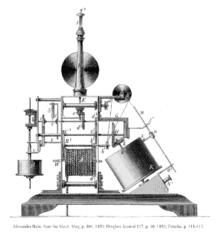Alexander Bain (inventor)
Alexander Bain (12 October 1810 – 2 January 1877)[1] was a Scottish inventor and engineer who was first to invent and patent the electric clock.
Bain frequented the lectures at the Polytechnic Institution and the Adelaide Gallery and later constructed his own workshop in Hanover Street.
In 1840, desperate for money to develop his inventions, Bain mentioned his financial problems to the editor of the Mechanics Magazine, who introduced him to Sir Charles Wheatstone.
When Wheatstone organised an Act of Parliament to set up the Electric Telegraph Company, the House of Lords summoned Bain to give evidence, and eventually compelled the company to pay Bain £10,000 and give him a job as manager, causing Wheatstone to resign.
He improved on this in later patents, including a proposal to derive the required electricity from an "earth battery", which consisted of plates of zinc and copper buried in the ground.
In December 1841, Bain in conjunction with Lieutenant Thomas Wright RN, patented a method for using electricity to control railway engines by turning off steam, marking time, giving signals, and printing information at different locations.
Bain also proposed to make the coil record messages by printing them, an idea he developed further in a subsequent patent.
In January 1846 he convinced the directors of the Stockton and Darlington Railway to install his telegraph between the north and south ends of their Shildon tunnel.
His telegraph was also successful abroad: "The initial Austrian Bain instruments were made by Johann Michael Ekling in Vienna, and later by the k.k.
In 1850 he applied for an improved version but was too late, as Frederick Bakewell had obtained a patent for his superior "image telegraph" two years earlier in 1848.
Bain's and Bakewell's laboratory mechanisms reproduced poor quality images and were not viable systems because the transmitter and receiver were never truly synchronized.
In 1861, the first practical operating electro-mechanical commercially exploited telefax machine, the Pantelegraph, was invented by the Italian physicist Giovanni Caselli.
He had seen that the Morse and other telegraphs then in use were comparatively slow, due to the mechanical inertia of their moving parts, and realized that the signal current could be used to make a readable mark on a moving paper tape soaked in a mixture of ammonium nitrate and potassium ferrocyanide, which gave a blue mark when a current was passed through it.
However, it incurred the hostility of Samuel Morse, who obtained an injunction against it on the grounds that the paper tape and alphabet used fell under his patent.


